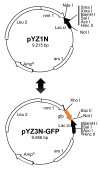Yeast for virus research
- PMID: 29082230
- PMCID: PMC5657823
- DOI: 10.15698/mic2017.10.592
Yeast for virus research
Abstract
Budding yeast (Saccharomyces cerevisiae) and fission yeast (Schizosaccharomyces pombe) are two popular model organisms for virus research. They are natural hosts for viruses as they carry their own indigenous viruses. Both yeasts have been used for studies of plant, animal and human viruses. Many positive sense (+) RNA viruses and some DNA viruses replicate with various levels in yeasts, thus allowing study of those viral activities during viral life cycle. Yeasts are single cell eukaryotic organisms. Hence, many of the fundamental cellular functions such as cell cycle regulation or programed cell death are highly conserved from yeasts to higher eukaryotes. Therefore, they are particularly suited to study the impact of those viral activities on related cellular activities during virus-host interactions. Yeasts present many unique advantages in virus research over high eukaryotes. Yeast cells are easy to maintain in the laboratory with relative short doubling time. They are non-biohazardous, genetically amendable with small genomes that permit genome-wide analysis of virologic and cellular functions. In this review, similarities and differences of these two yeasts are described. Studies of virologic activities such as viral translation, viral replication and genome-wide study of virus-cell interactions in yeasts are highlighted. Impacts of viral proteins on basic cellular functions such as cell cycle regulation and programed cell death are discussed. Potential applications of using yeasts as hosts to carry out functional analysis of small viral genome and to develop high throughput drug screening platform for the discovery of antiviral drugs are presented.
Keywords: Saccharomyces cerevisiae; Schizosaccharomyces pombe; cell cycle regulation; genome-wide analysis; high throughput drug screening; programed cell death; viral replication; virus-host interaction.
Conflict of interest statement
Conflict of interest: The author declares no conflict of interests.
Figures


References
-
- Yeong FM. Severing all ties between mother and daughter: cell separation in budding yeast. Mol Microbiol. 2005;55(5):1325–1331. - PubMed
-
- Nurse P. Cyclin dependent kinases and cell cycle control (nobel lecture). Chembiochem. 2002;3(7):596–603. - PubMed
-
- Hartwell L. Interview: Leland Hartwell, PhD, Nobel Prize for Medicine winner. MedGenMed. 2001;3(4):3. - PubMed
-
- Wood V, Gwilliam R, Rajandream MA, Nurse P. The genome sequence of Schizosaccharomyces pombe. Nature. 2002;415(6874):871–880. - PubMed
Publication types
Grants and funding
LinkOut - more resources
Full Text Sources
Other Literature Sources
Molecular Biology Databases
